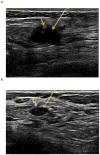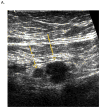Paradigm Shifts in Breast Care Delivery: Impact of Imaging in a Multidisciplinary Environment
- PMID: 27929664
- PMCID: PMC5482504
- DOI: 10.2214/AJR.16.17130
Paradigm Shifts in Breast Care Delivery: Impact of Imaging in a Multidisciplinary Environment
Abstract
Objective: The practice of breast imaging in a collaborative multidisciplinary environment adds significant value to outcomes in women's health care. In this article, we describe multidisciplinary considerations in breast cancer screening and early detection, the impact of imaging and histopathologic findings in the diagnostic evaluation and management of breast abnormalities, and the contribution of imaging to surgical and radiation therapy planning for the breast cancer patient.
Conclusion: The multidisciplinary delivery of breast care for women that incorporates screening, diagnosis of borderline and high-risk lesions, and management of the breast cancer patient adds considerable value to outcomes in health care.
Keywords: atypia; biopsy; breast cancer; lobular neoplasia; nodal metastases; ultrasound.
Figures





References
-
- [Accessed 07/28/2016];The NCCN Clinical Practice Guidelines in Oncology (NCCN Guidelines®) Breast Cancer Screening and Diagnosis (Version 1.2016) © 2016 National Comprehensive Cancer Network, Inc. Available at https://www.nccn.org. To view the most recent and complete version of the NCCN Guidelines®, go online to https://www.nccn.org.
-
- Fisher B, Costantino JP, Wickerham DL, et al. Tamoxifen for the prevention of breast cancer: current status of the National Surgical Adjuvant Breast and Bowel Project P-1 study. J Natl Cancer Inst. 2005;97:1652–1662. - PubMed
-
- Goss PE, Ingle JN, Alés-Martínez JE, et al. Exemestane for breast-cancer prevention in postmenopausal women. N Engl J Med. 2011;364(25):2381–2391. - PubMed
-
- Cuzick J, Sestak I, Forbes JF, et al. Anastrozole for prevention of breast cancer in high-risk postmenopausal women (IBIS-II): an international, double-blind, randomized placebo-controlled trial. Lancet. 2014;383(9922):1041–1048. - PubMed
Publication types
MeSH terms
Grants and funding
LinkOut - more resources
Full Text Sources
Other Literature Sources
Medical

